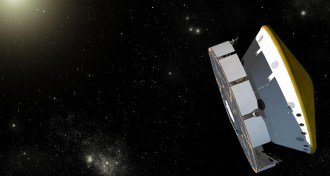Space
Sign up for our newsletter
We summarize the week's scientific breakthroughs every Thursday.
-
 Health & Medicine
Health & MedicineMars trip would deliver big radiation dose
Curiosity instrument confirms expectation of major exposures.
-
 Planetary Science
Planetary ScienceGone perhaps, but Kepler won’t soon be forgotten
Astronomers look forward to building on the planet-hunting telescope's discoveries.
By Andrew Grant -
 Space
SpaceKepler mission may be over
The planet-hunting telescope has been crippled by the failure of two out of four pointing devices.
By Andrew Grant -
 Space
SpaceMoon’s water may have earthly origins
Ratio of hydrogen to deuterium suggests molecule on both orbs has a common source.
By Andrew Grant -
 Space
SpaceAtom’s core gets pear-shaped
Tapering asymmetry of some nuclei confirms predictions.
By Andrew Grant -
 Space
SpaceSnapshots reveal details of Saturn’s gigantic hurricane
Storm dwarfs anything on Earth, with enormous eye and whipping winds.
By Erin Wayman -
 Space
SpaceLHC detects asymmetry in particle’s decay
While interesting, the imbalance in the decay of strange B mesons isn’t large enough to explain why matter predominates over antimatter in the universe.
By Andrew Grant -
 Space
SpaceComet’s water still hanging around on Jupiter
Shoemaker-Levy 9 supplied almost all of aqueous part of the planet's upper atmosphere.
By Andrew Grant -
 Space
SpaceAmerican Physical Society meeting
A supernova’s remnants possibly showing up in fossils and an explanation for the Crab Nebula are among highlights from the physics meeting.
By Andrew Grant -
 Astronomy
AstronomyMost Earthlike planets yet seen bring Kepler closer to its holy grail
Space telescope finds globes that, compared with our world, are slightly larger and orbit a smaller star.
By Andrew Grant -
 Planetary Science
Planetary ScienceFaint Young Sun
Scientists struggle to understand how early Earth stayed warm enough for liquid water.
By Erin Wayman -
 Cosmology
CosmologyDark matter detector reports hints of WIMPs
Experiment hundreds of meters underground detects three candidate signs of dark matter, though physicists are cautious about the finding.
By Andrew Grant